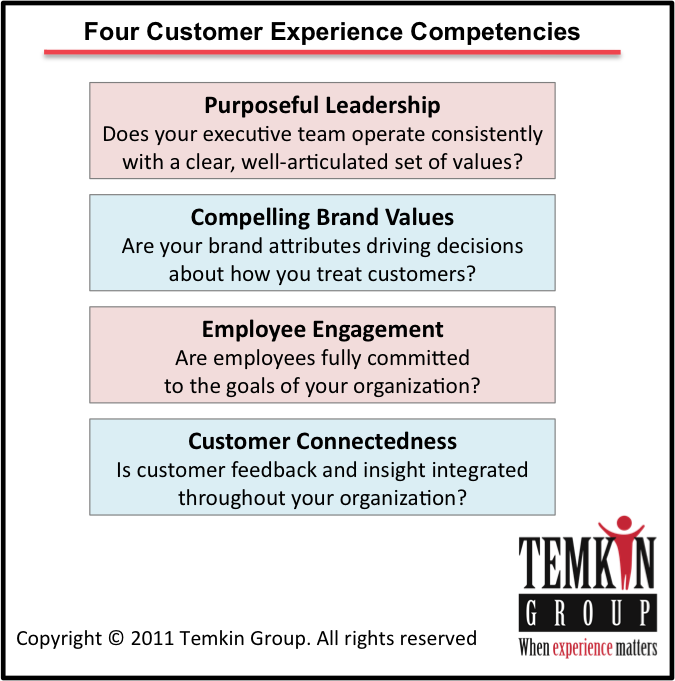Why do some companies create loyal fans while others alienate their customers? How can some organizations deliver consistently good experiences while others regularly falter?
There are a lot of reasons why some companies outperform others. But one of the underappreciated areas is customer experience (CX). Sure, companies often say they are customer-centric, but only a handful put the time and energy into becoming customer-centric. That’s why it was not a huge surprise to find that only 16% of companies received “good” or “excellent” ratings in the 2011 Temkin Experience Ratings.
The Elements Of Great Customer Experience
The Temkin Experience Ratings are based on asking 6,000 US consumers to rate their recent experience with companies along three dimensions:
- Functional: How well did the experiences meet their needs?
- Accessible: How easy was it for them to do what they wanted to do?
- Emotional: How did they feel about the experiences?
Companies that want to be great, or even good, need to consistently interact with customers in a way that meets their customers’ needs, is easily accessible, and reinforces the emotional components of the company’s brand. While that may sound straightforward, it’s not easy to do and requires a lot of focus from the entire company.
In general, companies were rated higher on the functional portion of the experience than they were on the accessible and emotional components. That’s consistent with what we’ve found. Companies may focus on what customers are trying to accomplish, but spend woefully too little time making it easy for customers or thinking about how their interactions make customers feel.
Tips For Delivering The Total Experience
There’s no magic formula for CX success. This quote by Colin Powell describes what it takes:
If you are going to achieve excellence in big things, you develop the habit in little matters. Excellence is not an exception, it is a prevailing attitude.
In order for companies to make great CX a “prevailing attitude,” they need to master four competencies:
1. Purposeful Leadership
Temkin Group research consistently shows that the number one obstacle to CX success is “other competing priorities.” That issue falls squarely on the shoulders of the executive team. It’s very easy to shoot off a few emails and claim that CX is important. But if the executive team doesn’t behave like it’s important, then why should the rest of the organization?
Example: Mayor Corey Booker Of Newark captured the essence of leadership in this quote: “My mom used to say that who you are speaks so loudly that I can’t hear what you say.”
2. Employee Engagement
If employees are not aligned with the goals of the company then there’s no way they will be able to deliver great experiences for customers. So any CX effort that does not engage employees will likely fail.
Example: The Container Store understands this principle, which is why they make enormous investments in training and supporting their employees. Here’s how the company’s website described its “We Love Employees Day,” which it held on Valentine’s Day:
…we all believe that if you work to make your employees the happiest employees around, well then they will absolutely, positively then make our customers the happiest customers around. And if those two are ecstatic, then wonderfully, and almost ironically, you’ll have the happiest shareholders around, too.
3. Compelling Brand Values
Brands are more than marketing slogans and advertising campaigns; they represent the organization’s raison d’être. We often describe a true brand as “the fabric that aligns all employees with customers in the pursuit of a common cause.” So companies need to understand their brand promises and make sure they deliver on them during every interaction with customers.
Example: JetBlue knew that it needed to live up to its “Jetitude” branding by delivering a great experience with its people. So it translated the brand promise into five specific behaviors for its front-line employees:
- Be in Blue always
- Be personal
- Be the answer
- Be engaging
- Be thankful to every customer
4. Customer Connectedness
Every time a customer interacts with your company, it leaves an imprint on them, pushing them either towards higher loyalty or further on the path to abandonment. But most companies don’t know what effect they are having on customers—never mind what they can do to make improvements. That’s why companies need to develop systematic approaches like “voice of the customer” programs for collecting and responding to customer feedback.
Example: Sizzler has gone through a major turnaround over the last couple of years by making sure that it truly understood its customers. Here’s how CEO Kerry Kramp describes how the restaurant chain made its improvements:
We kept our finger right on the pulse of the guests’ feedback. As they gave us indications of what they liked—either verbally or through the product mix, what were they ordering—we kept adapting our business to the direction that they wanted us to head in.
Closing Thoughts
Companies can’t transform into CX leaders overnight. But if they focus on the total experience—functional, accessible, and emotional—and build CX competencies, then they we will be heading in the right direction. And who knows, maybe some of these firms will show up as new leaders in the 2012 Temkin Experience Ratings.








